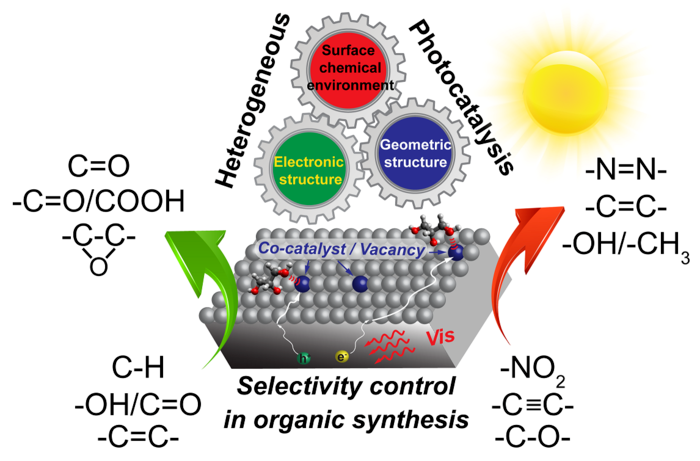Selectivity refers to the ability to control the products and byproducts of a chemical reaction. Scientists are attempting to increase selectivity in industrial chemical processes to improve chemical product quality, eliminate wasted byproducts, and minimize harmful byproducts, such as CO2 emissions.
 Researchers demonstrated how products and byproducts of chemical reactions could be sustainably and easily controlled by applying heterogeneous photocatalysis. Image Credit: Nano Research Energy.
Researchers demonstrated how products and byproducts of chemical reactions could be sustainably and easily controlled by applying heterogeneous photocatalysis. Image Credit: Nano Research Energy.
In chemical processes, scientists can utilize a variety of catalytic modes. Heterogeneous, homogeneous, and biological catalysis are all catalytic modes, but heterogeneous catalysis has numerous benefits over the others, such as the ability to function constantly and scale easily. Researchers wanted to see if it may help with selectivity in commercial chemical reactions as well.
Researchers used heterogeneous photocatalysis to show how chemical reaction products and byproducts might be simply and sustainably regulated. The use of light in chemical processes where the catalyst and reactor are in different phases is known as heterogeneous photocatalysis. Researchers are particularly interested in this approach since the conditions required are quite mild.
A paper published in Nano Research Energy on May 12th, 2022, highlighted the process and its implications for selectivity in chemical synthesis.
No matter what kinds of catalytic systems are employed, one key evaluation indicator always dominates, especially in the field of organic synthesis: the selectivity of desired products. High selectivity not only provides the high purity of final products, but it also reduces the cost of removing byproducts.
Yitao Dai, Study Author and Professor, Suzhou Institute for Advanced Research, University of Science and Technology
Dai stated, “In contrast, undesired over oxidation or over reduction leads to low-value products, coke deposition, or even mineralization with the emission of useless CO2. Therefore, it is one main and important scientific subject in organic chemistry how to precisely control selectivity.”
Researchers showed how heterogeneous photocatalysis may enhance a wide range of organic transformations in a variety of sectors. The pulp and paper sector, for example, is a well-known polluter, with lignin as a byproduct contributing to the pollution.
The pulp and paper industry produces over 50 million tons of lignin-containing waste every year, but only 2% of that can be recovered and reused. In modest settings, researchers demonstrated how heterogeneous photocatalysis may break down lignin.
This type of research aims to reduce the environmental cost of industrial chemical processes.
Given the current global theme of development in CO2 reduction and sustainable energy utilization, heterogeneous photocatalysis can act as one promising protocol to control selectivity in organic transformations with reduced energy consumption. It enables sustainable solar-to-chemical energy conversion under mild conditions and offers unique reaction pathways for improved selectivity control.
Yitao Dai, Study Author and Professor, Suzhou Institute for Advanced Research, University of Science and Technology
The moderate conditions that may be employed to complete chemical reactions are one advantage of heterogeneous photocatalysis. The use of air as an oxidant, a mild room temperature, and the use of ambient pressure are all examples of these. When compared to other techniques, this makes it easier to use.
In the future, researchers are considering the implications of widely employing this technology. The ultimate objective of the researchers is to develop an artificial photosynthetic plant. Using heterogeneous photocatalytic devices would allow for the long-term, continuous generation of organic molecules. This approach would be low-cost, effective, and solar-powered. However, further study is required in the meantime.
For the field of organic synthesis via heterogeneous photocatalysis, more and more research focus should be on two aspects. First, existing challenging reactions. Second, new organic reactions. We expect that the design of novel reaction routes based on the catalytic properties of photocatalysts may provide a solution for some quite challenging organic syntheses, generating products with high regioselectivity or asymmetry.
Yitao Dai, Study Author and Professor, Suzhou Institute for Advanced Research, University of Science and Technology
Yujie Xiong of the University of Science and Technology of China’s School of Chemistry and Materials Science in Hefei, China, also contributed to this study.
This research was financed by China’s National Key R&D Program, the Natural Science Foundation of China, the DNL Cooperation Fund, CAS, and a startup grant from the University of Science and Technology of China.
Journal Reference:
Dai, Y. & Xiong, Y. (2022) Control of selectivity in organic synthesis via heterogeneous photocatalysis under visible light. Nano Research Energy. doi.org/10.26599/NRE.2022.9120006.